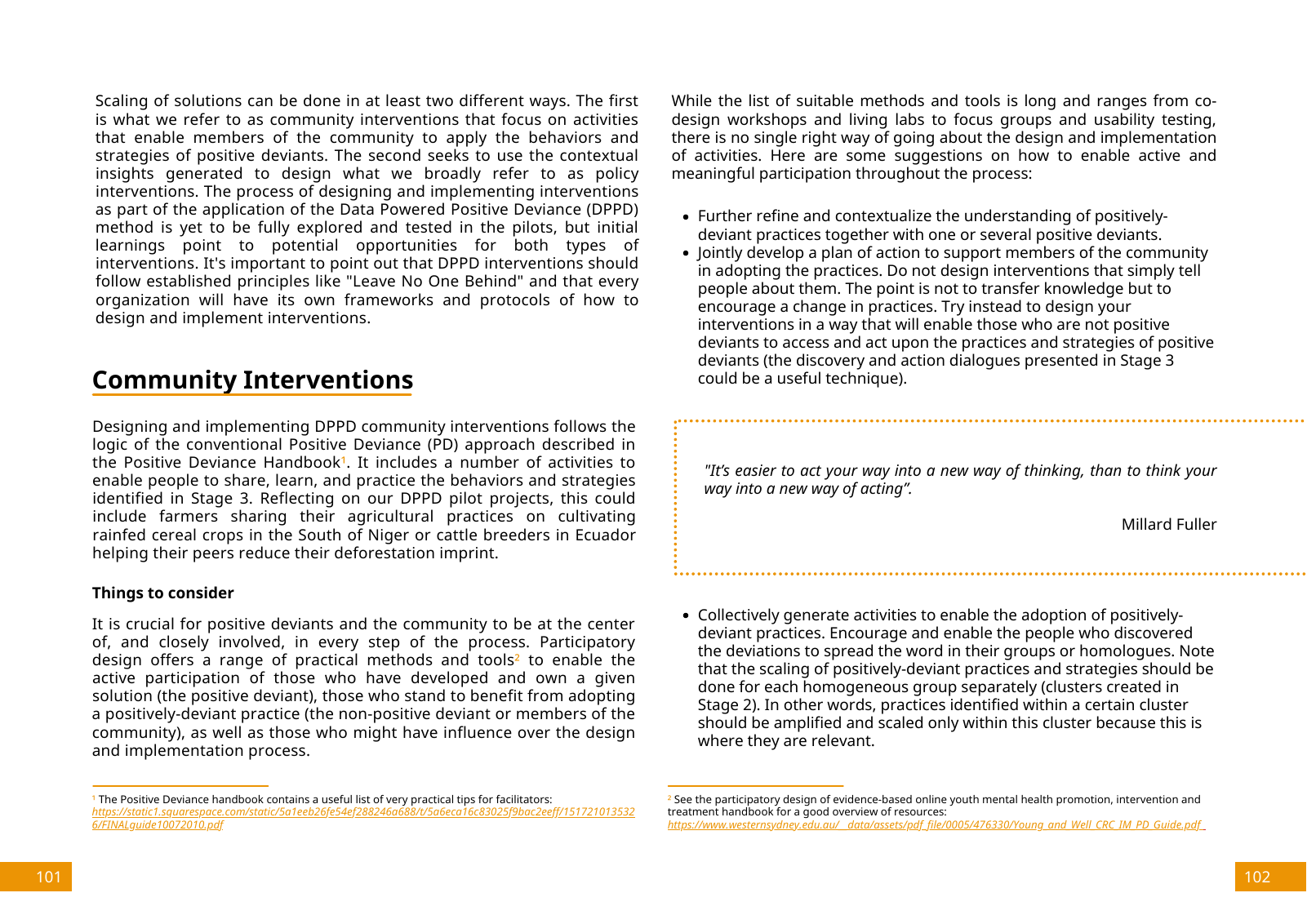Scaling of solutions can be done in at least two different ways The first is what we refer to as community interventions that focus on activities that enable members of the community to apply the behaviors and strategies of positive deviants The second seeks to use the contextual insights generated to design what we broadly refer to as policy interventions The process of designing and implementing interventions as part of the application of the Data Powered Positive Deviance DPPD method is yet to be fully explored and tested in the pilots but initial learnings point to potential opportunities for both types of interventions It s important to point out that DPPD interventions should follow established principles like Leave No One Behind and that every organization will have its own frameworks and protocols of how to design and implement interventions The Positive Deviance handbook contains a useful list of very practical tips for facilitators https static1 squarespace com static 5a1eeb26fe54ef288246a688 t 5a6eca16c83025f9bac2eeff 151721013532 6 FINALguide10072010 pdf While the list of suitable methods and tools is long and ranges from co design workshops and living labs to focus groups and usability testing there is no single right way of going about the design and implementation of activities Here are some suggestions on how to enable active and meaningful participation throughout the process Community Interventions Designing and implementing DPPD community interventions follows the logic of the conventional Positive Deviance PD approach described in the Positive Deviance Handbook It includes a number of activities to enable people to share learn and practice the behaviors and strategies identified in Stage 3 Reflecting on our DPPD pilot projects this could include farmers sharing their agricultural practices on cultivating rainfed cereal crops in the South of Niger or cattle breeders in Ecuador helping their peers reduce their deforestation imprint Things to consider It is crucial for positive deviants and the community to be at the center of and closely involved in every step of the process Participatory design offers a range of practical methods and tools to enable the active participation of those who have developed and own a given solution the positive deviant those who stand to benefit from adopting a positively deviant practice the non positive deviant or members of the community as well as those who might have influence over the design and implementation process It s easier to act your way into a new way of thinking than to think your way into a new way of acting Millard Fuller Further refine and contextualize the understanding of positively deviant practices together with one or several positive deviants Jointly develop a plan of action to support members of the community in adopting the practices Do not design interventions that simply tell people about them The point is not to transfer knowledge but to encourage a change in practices Try instead to design your interventions in a way that will enable those who are not positive deviants to access and act upon the practices and strategies of positive deviants the discovery and action dialogues presented in Stage 3 could be a useful technique See the participatory design of evidence based online youth mental health promotion intervention and treatment handbook for a good overview of resources https www westernsydney edu au data assets pdf file 0005 476330 Young and Well CRC IM PD Guide pdf Collectively generate activities to enable the adoption of positively deviant practices Encourage and enable the people who discovered the deviations to spread the word in their groups or homologues Note that the scaling of positively deviant practices and strategies should be done for each homogeneous group separately clusters created in Stage 2 In other words practices identified within a certain cluster should be amplified and scaled only within this cluster because this is where they are relevant 101 102

Hinweis: Dies ist eine maschinenlesbare No-Flash Ansicht.
Klicken Sie hier um zur Online-Version zu gelangen.
Klicken Sie hier um zur Online-Version zu gelangen.